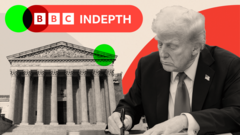Is Trump Transforming Presidential Power Through the Courts?

The Shifting Landscape of Judicial Power in the Trump Era
The landscape of judicial power in the United States has undergone dramatic shifts during the Trump administration, fundamentally altering the relationship between the presidency and the courts. In recent years, the judiciary has faced unprecedented challenges, with judges increasingly becoming targets of political rhetoric and threats of violence. At the center of this tumult is the former president, Donald Trump, whose confrontational approach to the judiciary raises critical questions about the future of constitutional balance in America.
As we delve into the complexities of this evolving narrative, it is essential to understand the historical context that has brought us to this moment. The judiciary has long served as a counterbalance to executive power, ensuring that the rule of law prevails. Yet, under Trump's leadership, this delicate equilibrium has been tested in ways not previously seen in American politics.
The Rise of Judicial Hostility
Judges have increasingly found themselves in the crosshairs of political attacks, with terms like "crooked," "activist," and "radical left" becoming commonplace in political discourse. Trump’s rhetoric has not only sparked public hostility but has also led to real-world consequences for judges carrying out their duties. Reports indicate a significant rise in threats against judges, with the US Marshals Service documenting over 400 threats to judges by mid-2023—surpassing the total for the entire previous year.
This hostile environment has prompted a reevaluation of the role of the judiciary in American democracy. Judges, who are meant to be impartial arbiters, are now facing a barrage of threats and intimidation, which some experts argue is a direct result of the inflammatory rhetoric employed by the administration. The implications of this shift are significant, as they threaten not only the safety of individual judges but the integrity of the judicial system as a whole.
Historical Precedents and the Current Crisis
To fully grasp the ramifications of these developments, one must consider the historical precedents that have shaped the judiciary's role in America. The founding fathers established a system of checks and balances to prevent any one branch of government from gaining too much power. However, the current administration has challenged this framework, with Trump’s aggressive use of executive orders and attacks on judicial authority pushing the boundaries of presidential power.
For instance, Trump's administration has issued a staggering number of executive orders—over 140 by mid-2023—many of which have faced legal challenges. The judiciary's ability to intervene has been crucial in curbing potential overreach. However, the aggressive pushback from the administration against judicial rulings raises questions about the future of judicial independence.
The Supreme Court's Role in Shaping Judicial Authority
In recent months, major Supreme Court rulings have further complicated the dynamics between the presidency and the judiciary. Landmark decisions have granted former presidents broad immunity from prosecution and dismissed challenges that sought to disqualify Trump from future office based on his actions during and after the 2020 election. These rulings have emboldened Trump's administration, leading to a more aggressive stance against the judiciary.
The implications of these decisions are profound, as they not only shape the current political landscape but also set precedents for future administrations. The Supreme Court’s conservative majority, reshaped under Trump, has become a powerful ally in the ongoing battle for judicial authority, emboldening the executive branch and raising concerns about the erosion of judicial independence.
Judicial Responses to Executive Overreach
Despite the challenges posed by the administration, judges have shown resilience in the face of adversity. Recent rulings have demonstrated that the judiciary is willing to assert its independence, even when met with hostility from the executive branch. For instance, judges have issued nationwide injunctions against various executive orders, challenging the legality of policies that infringe upon constitutional rights.
This pushback is not without risks, as judges face increasing threats and intimidation as a result of their rulings. The rise in doxxing incidents and threats of violence against judges has created an environment of fear, prompting some judges to reconsider their roles and responsibilities in the current political climate. The ongoing battle between the judiciary and the executive branch raises crucial questions about the future of the rule of law in America.
Public Perception and the Role of Media
The media plays a crucial role in shaping public perception of the judiciary and its relationship with the executive branch. The portrayal of judges and judicial decisions in the media can influence public opinion and, in turn, impact the judiciary's ability to function independently. In a climate where judicial independence is under threat, responsible reporting and analysis become more important than ever.
As public trust in the judiciary wanes, the potential for backlash against judges increases. The media's role in framing the narrative around judicial decisions can either bolster or undermine public confidence in the judicial system. A nuanced understanding of the complexities at play is essential for fostering an informed public discourse on these critical issues.
Looking Ahead: The Future of Judicial Independence
The future of judicial independence in the United States hangs in a precarious balance. As the Trump administration continues to assert its authority, the judiciary must navigate a landscape marked by hostility and aggression. The ability of judges to operate without fear of retribution is paramount to maintaining the integrity of the judicial system.
As we move forward, it is essential to consider the long-term implications of this struggle for power. Will the judiciary emerge stronger from this confrontation, or will the erosion of judicial authority lead to a fundamental shift in the balance of power within the government? The answers to these questions will shape the future of American democracy.
Conclusion: The Enduring Fight for Judicial Integrity
In conclusion, the battle between the presidency and the judiciary represents a critical moment in American history. The challenges faced by judges in the current political climate are unprecedented, raising important questions about the future of the rule of law and the system of checks and balances established by the founding fathers. As the landscape continues to evolve, the resilience of the judiciary will be tested, and the outcome will have lasting implications for the future of democracy in the United States.
FAQs
What are the main challenges facing judges today?
Judges today face numerous challenges, including increased public hostility, threats of violence, and political pressure. These factors can undermine their ability to make impartial decisions and maintain judicial independence.
How has Trump's administration affected the judiciary's role?
Trump's administration has challenged the judiciary's authority through aggressive rhetoric, executive orders, and attempts to undermine judicial decisions. This has led to a significant shift in the balance of power between the presidency and the courts.
What can be done to protect judicial independence?
Protecting judicial independence requires a multifaceted approach, including public support for the rule of law, responsible media reporting, and legislative measures to enhance judicial security and integrity. It is essential for the judiciary to be able to operate free from political interference.
As we reflect on these pressing issues, one must ponder: How can we ensure the preservation of judicial independence in the face of mounting challenges? #JudicialIndependence #RuleOfLaw #TrumpEra
```Published: 2025-07-21 23:14:03 | Category: wales



